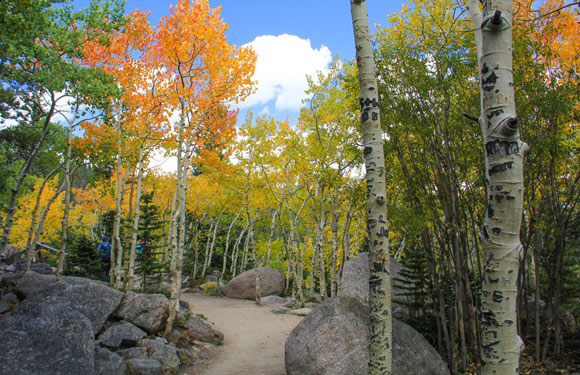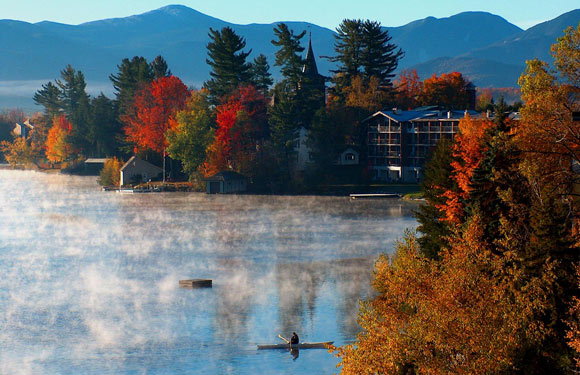The crisp air of autumn has arrived in many places across the country, providing runners with a chance to delve into nature and watch its colorful transformation.
To get your fall foliage fix while you log miles, consider these five fantastic destinations.
Denver, Colorado—and surrounding areas.
1 of 6
Thanks to the region's famous mountains, awesome displays of autumn color last especially long.
Depending on the elevation, leaves reach their peak beauty from mid-September to mid-November. The cascade of colors begins at 8,000-10,000 feet above sea level, where aspen trees start to turn gold in September. By October and November, stunning colors also fill the foothills.
Jessica Griffiths, managing editor of Colorado Runner, says The Devil's Head Lookout Trail in Pike National Forest, 50 miles south of Denver, is one of her favorites. "The drive on Rampart Range Road to get to the trail has pretty fall colors and when you reach the summit of the run, you have 360 degree views of the changing leaves," she says.
In addition, Rocky Mountain National Park, a 90-minute drive from Denver, and the Maroon Bells, just outside Aspen, offer tons of options for runners looking to soak in the seasonal splendor.
The Maroon Bells, which features two peaks, is one of the most photographed places in the state during the fall, making it a go-to stop for trail runners and photographers.
The trails at Golden Gate Canyon State Park, 20-miles west of Denver, won't disappoint either.
Find a
race.The Adirondacks, New York
2 of 6
Millions flock to New York for its famous big city, but the Adirondack region along the Canadian border is an enduring favorite for those who want a break from the bustle. The Adirondack region encompasses more than six million acres of wilderness, making it the largest publicly protected natural area in the continental United States.
During the fall, the Adirondacks' huge collection of deciduous trees is a big draw for leaf peepers. Many head to Lake Placid, a village in the heart of the Adirondacks that's famous for hosting two Olympic Winter Games.
The Brewster Peninsula Nature Trails is a good place to start. Located along the shores of Lake Placid, these well-maintained dirt trails are short—less than a mile each—but can be combined to create longer loops.
If you'd rather stay on flat pavement, jog along Mirror Lake, dubbed the "Central Park" of Lake Placid. The 2.7-mile loop is great for runners interested in checking out the village itself.
For a longer workout, you can run a portion of the course for the Lake Placid Marathon and Half Marathon, which is held every June. Begin at Olympic Speed Skating Oval, go clockwise around Mirror Lake to Parkside Drive and turn left. Follow the road to Route 73. This will take you past the Horse Show Grounds and Olympic Games ski jumps. At this point, you can turn around or make a left on River Road, where you'll get cool views of the Ausable River and nearby mountains.
Find a
race.Columbia River Gorge, Oregon and Washington
3 of 6
Straddling the border of Oregon and Washington, this gorgeous river canyon is 80 miles long and up to 4,000-feet deep. In 1986, President Ronald Reagan declared it a National Scenic Area, allowing for both wilderness protection and carefully managed development.
The region is especially spectacular during the fall, when regular rain returns to replenish the waterfalls, explains Maegan Jossy, outreach manager for Friends of Columbia Gorge.
"As leaves start to fall, peek-a-boo views open up that you can't see when the trees have full foliage," she says. "The fall is also a great time to visit because the summer crowds have left, and many areas are quieter."
The Friends of Columbia Gorge recommend a host of trails throughout the region, including the Klickitat Trail along the Klickitat River in Washington and Deschutes River Trail in East Gorge, Ore.
If you're not in the mood for a muddy trail, the Mosier Twin Tunnels trail in East Gorge, Ore., is a paved path. Part of the Historic Columbia River Highway State Trail, the old road and its abandoned tunnels were reopened to the public in 2000. The 14-mile out-and-back highway section from the Hood River to Mosier has excellent sights of the gorge.
Find a
race.The Dakotas
4 of 6
Sparsely populated—there are just 1.6 million people total in North and South Dakota—but filled with an abundance of natural beauty, the Dakotas are incredible destinations in the fall. They encompass some 144,000-square miles, a vast wilderness that explodes into dazzling shows of red, gold and orange.
For an autumn running adventure in North Dakota, check out the state park trails at places like Turtle River State Park, located 20 miles west of Grand Forks, Fort Ransom State Park in Fort Ransom, and Lake Metigoshe State Park, located 14 miles northeast of Bottineau.
The leaves turn early in North Dakota, so plan your visit for early-to-mid October to catch the colors at their best.
Though South Dakota is best known as the home of Mount Rushmore, it's not the only magnificent attraction in the state's Black Hills region. The 109-mile long George S. Mickelson Trail, an old railway that was restored for public use in the 1990s, cuts through the heart of the Black Hills, extending from Deadwood in the north to Edgemont in the south.
The gravel path is dotted with 15 trailheads, where you can find parking, restrooms and self-pay trail pass stations. The trail's grade doesn't go above four percent, but some sections are considered strenuous.
Find a
race.Northern Michigan, Lake Michigan
5 of 6
Heather Johnson Durocher, founder and editor of Michiganrunnergirl.com, says fall running in Michigan is "magical."
"I especially like going on the trails, where it's peaceful and quiet, and the colors literally are breathtaking," she says. "I usually stop at certain points during my run just to pause and take in the incredible scenery."
One of Durocher's favorites is the Vasa Pathway inside the Pere Marquette State Forest, located near Traverse City in western Michigan. Runners can choose from a series of 3K, 5K, 10K and 25K loops, but the hilly terrain makes all of them challenging.
For amazing Lake Michigan views, Durocher recommends The Sleeping Bear National Lakeshore tucked west of Traverse City.
"The Sleeping Bear National Lakeshore is known for its stunning scenery, which includes miles of Lake Michigan shoreline, towering dunes, two islands, wooded trails and crystal-clear inland lakes," she says.
In 2011, Good Morning America named it the Most Beautiful Place in America.
The trails at Arcadia Dunes: C.S. Mott Preserve and Dunes' Green Point Dunes Nature Preserve also offer wooded escapes that lead to sweeping views of Lake Michigan.
Find a
race.Get ACTIVE on the Go


Couch to 5K®
The best way to get new runners off the couch and across the finish line of their first 5K.
Available for iOS | Android






Discuss This Article